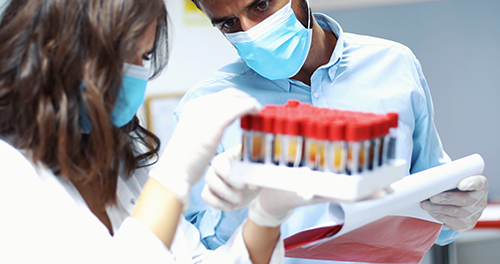
Even as the COVID-19 pandemic pushed clinical laboratories to their limits, AACC members remained focused on their mission to advance the science and practice of laboratory medicine, publishing landmark scientific guidance in 2021. These documents promise to expertly guide care and improve patient outcomes -- not only for COVID-19, but for other critical issues in medicine, such as acute kidney injury (AKI) and biomarkers for preterm birth.
An Essential Update on SARS-CoV-2 Serology
This year, AACC convened an expert panel to develop recommendations for implementing and interpreting evolving SARS-CoV-2 serologic testing. The group published their recommendations in Clinical Chemistry (Clin Chem 2021; doi:10.1093/clinchem/hvab051), with a more in-depth document available on AACC’s website, www.myadlm.org.
The guidance document provides information about serologic assay design, antibody classes, and the kinetics of the humoral immune response, as well as assay verification and validation.
It also tackles four indications for serologic testing: supporting the diagnosis of COVID-19 and related sequelae (i.e., multisystem inflammatory syndrome in children); identifying potential convalescent plasma donors and manufacturing of convalescent plasma; epidemiologic and seroprevalence studies; and vaccine efficacy studies.
“Though various organizations have published guidelines on clinical utilities of serology testing, ours is the first and most comprehensive document we know so far for the implementation of the tests,” said Y. Victoria Zhang, PhD, MBA, vice chair for clinical enterprise strategy and director of clinical chemistry for the University of Rochester Medical Center, in New York, and the publication’s lead author.
Importantly, the guideline authors said that serology tests are not recommended for diagnostic purposes for SARS-CoV-2 infection, but they could identify different types of antibodies, such as IgG and IgM, and antibodies for S and N proteins or neutralizing antibodies.
Separately, AACC also issued a statement that details the limitations of cycle threshold values (Ct), recommending against their use for patient care. The statement emphasizes that, even though Ct values correlate with the amount of virus in specific specimens, studies have not established a relationship between Ct values and a patient’s overall viral load or infectiousness.
In recommending against this use of Ct values, AACC emphasized that there are numerous factors aside from the amount of virus in a specimen that can impact the Ct values generated during coronavirus testing—from patient age, the test instruments used, and even whether or not a patient exhales forcefully through the nose before sample collection.
Improving Precision for AKI
AACC’s evidence-based guidance document on laboratory investigation of AKI, released by the AACC Academy, aims to better guide clinicians and laboratorians in an environment of rapidly evolving science. Compiled by a multidisciplinary group of laboratory scientists and nephrologists (J Appl Lab Med 2021;jfab020. doi:10.1093/jalm/jfab020), the guidance outlines 13 findings and recommendations for monitoring AKI, traditional and new biomarkers affiliated with the condition, and the value of automated alerts.
Critically, the recommendations include a proposal for new diagnostic thresholds, called the 20/20 AACC AKI criteria, when determining whether a patient has AKI with creatinine testing. AKI traditionally has been identified through a rise in blood creatinine and/or a fall in urine output, noted Joe El-Khoury, PhD, DABCC, FADLM, chair of the guidance writing committee and director of the Clinical Chemistry Laboratory at Yale-New Haven Health, in Connecticut. However, there have been significant developments over the last decade in this space.
New biomarkers and electronic tools have emerged to help predict which patients are at greater risk for developing AKI or identify early changes. But literature studies and access to these technologies have been variable, leading to disparities in the identification and management of AKI among medical centers, El-Khoury said.
The 20/20 AACC AKI criteria outlined in the new guidance recommends using a +0.20 mg/dL (~20 µmol/L) change in creatinine when baseline is less than 1.00 mg/dL (~90 µmol/L), or a +20% change when baseline blood creatinine is greater than 1.00 mg/dL. This could improve sensitivity for AKI detection.
Clarity on Preterm Birth Biomarkers
As a leading cause of infant death, preterm birth is an urgent risk that clinicians are eager to address. However, many biomarkers on the market provide limited value, according to a guideline from AACC also released this year.
The AACC guideline does not recommend routinely measuring interleukin 6 (IL-6), placental alpha microglobulin 1 (PAMG-1), or fetal fibronectin (fFN) in pregnant women with symptoms consistent with preterm delivery. These biomarkers have low positive predictive values (PPVs) and provide limited utility in diagnostic algorithms most commonly used in the U.S., according to the guidance.
Despite the guideline’s negative stance on these markers’ routine use, the document does not encourage clinical laboratorians to issue unilateral decrees about these tests. “Decisions should be made with the obstetricians in a collaborative effort,” said senior author Robert D. Nerenz, PhD, DABCC, assistant director, clinical chemistry, and assistant professor of pathology and laboratory medicine at the Geisel School of Medicine and Dartmouth-Hitchcock Medical Center in Lebanon, New Hampshire.
Learn more about these and other AACC guidance and scientific resources online by visiting www.myadlm.org, and clicking on the Science & Research tab.
Parts of this article have been adapted from information that originally appeared in the July-August and October issues of Clinical Laboratory News.